高教版中职英语基础模块第2册Unit10Whywasitbuiltword说课稿-精品
- 格式:docx
- 大小:24.80 KB
- 文档页数:5
![高教社中职英语基础模块2 Unit_10[优讲课堂]](https://uimg.taocdn.com/5afd06cedaef5ef7ba0d3c6e.webp)

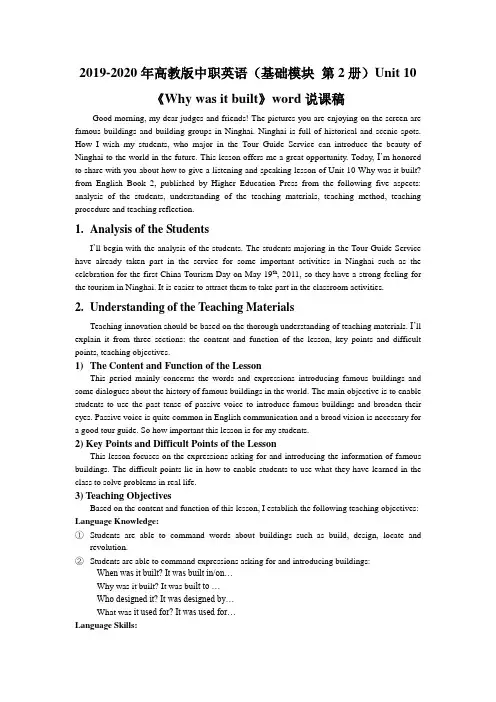
2019-2020年高教版中职英语(基础模块第2册)Unit 10《Why was it built》word说课稿Good morning, my dear judges and friends! The pictures you are enjoying on the screen are famous buildings and building groups in Ninghai. Ninghai is full of historical and scenic spots. How I wish my students, who major in the Tour Guide Service can introduce the beauty of Ninghai to the world in the future. This lesson offers me a great opportunity. Today, I’m honored to share with you about how to give a listening and speaking lesson of Unit 10 Why was it built? from English Book 2, published by Higher Education Press from the following five aspects: analysis of the students, understanding of the teaching materials, teaching method, teaching procedure and teaching reflection.1.Analysis of the StudentsI’ll begin with the analysis of the students. The students majoring in the Tour Guide Service have already taken part in the service for some important activities in Ninghai such as the celebration for the first China Tourism Day on May 19th, 2011, so they have a strong feeling for the tourism in Ninghai. It is easier to attract them to take part in the classroom activities.2.Understanding of the Teaching MaterialsTeaching innovation should be based on the thorough understanding of teaching materials. I’ll explain it from three sections: the content and function of the lesson, key points and difficult points, teaching objectives.1)The Content and Function of the LessonThis period mainly concerns the words and expressions introducing famous buildings and some dialogues about the history of famous buildings in the world. The main objective is to enable students to use the past tense of passive voice to introduce famous buildings and broaden their eyes. Passive voice is quite common in English communication and a broad vision is necessary fora good tour guide. So how important this lesson is for my students.2) Key Points and Difficult Points of the LessonThis lesson focuses on the expressions asking for and introducing the information of famous buildings. The difficult points lie in how to enable students to use what they have learned in the class to solve problems in real life.3) Teaching ObjectivesBased on the content and function of this lesson, I establish the following teaching objectives: Language Knowledge:①Students are able to command words about buildings such as build, design, locate andrevolution.②Students are able to command expressions asking for and introducing buildings:When was it built? It was built in/on…Why was it built? It was bui lt to …Who designed it? It was designed by…What was it used for? It was used for…Language Skills:①Students are able to predict before listening and listen for detailed information by catching thekey words to understand the dialogues talking about the famous buildings②Students are able to talk about the famous buildings with each other by using the key wordsand expressionsCultural Awareness: Students are able to get familiar with the history of some famous western buildings.Affection:①Students are able to broaden their eyes by getting familiar with some famous buildings in theworld and love their own hometown by introducing its famous buildings.②Students are able to cooperate with others by selectively putting the materials together tomake an introduction of one famous building.3.Teaching MethodsTo achieve the above teaching objectives, situational teaching method and task-based language teaching method are adopted in this class.4.Teaching ProceduresT eaching procedures are the most important of a successful teaching. Before class, apart from making a multi-media courseware and Question-Answer cards which will be used in the speaking activity, I’ll divide the students into groups of 6 according to their language ability. As for the students, they need to collect materials about famous buildings in Ninghai (such as pictures, videos, the location and so on). With everything prepared, here come the six teaching steps:Step 1: Lead-inI will play the video showing famous buildings in Ninghai one minute before class to help students begin their English learning in a relaxing atmosphere.With the help of the video, I smoothly begin the class by talking about the tourism in Ninghai to activate students’ background knowledge and preset a task for the students: it is your honorable duty to introduce the famous buildings in Ninghai to the world. And all the following activities are to help them prepare for this duty.First of all, broaden their eyes. A matching competition will be held between groups and details about the buildings will be introduced later by showing more pictures and asking them the following questions: Where is it? Why was it built? to lead in the study of key expressions. Group cooperation can relieve students’ fear caused by the unfamiliarity with the English expressions of these famous buildings while group competition can fully motivate their learning enthusiasm.Step 2: ListeningThe students may know a lot about one famous building, but how to introduce it to tourists? I will introduce the magical blanket of Aladdin to link different teaching steps and change the whole boring listening process into a wonderful traveling to enjoy famous buildings in the world and experience how to guide a tourist to visit famous buildings at the same time. This is the point where I integrate the teaching materials and set an interesting situation for students.Students are certainly eager to begin their traveling, but which buildings are we going to visit? They will listen to three tour guides introducing the three buildings and order the pictures. This step serves as preparation for the following activities by briefly introducing the background knowledge of three buildings, which follows the study law-from the easy to the difficult.Then we will arrive in the first stop of our wonderful travel-the Statue of Liberty. I’ll ask the students: If you are the tour guide, what questions do you think the tourists will ask? Do you know the answers? With their own predictions in mind, a flash will be followed to check the answers by circling the questions they hear and completing the fact file. In the above process, students are not passively asked to do some meaningless listening activities. Instead, they actively explore for the information through different listening strategies directed by different questions and experience the use of key expressions. The information technology makes it possible to let students play an initiative role in a vivid learning environment.Step 3: SpeakingThe Statue of Liberty is a gift from the French people, so in the following step, I’ll lead students to France to visit the Eiffel Tower. Students need to win the passports for themselves by helping the magical blanket finish the Question-Answer cards. They will read aloud after the tape, underline the questions about the information of buildings to put into the Question card of a tourist and then find the answers to put into the Information card of a tour guide. The listening activities act as a role of implicit learning, and then this activity is to cultivate students’ ability to summarize and help students command the key expressions in an explicit way.After receiving enough input, now it’s time for the students to output. I will lead them to visit the Eiffel Tower by showing a flash to let students understand how to use Question-Answer cards to act out a dialogue. After that, we will be in the last stop of our wonderful travel. It’s students’turn to guide me to visit the Great Wall. A video showing its beautiful scenery will be played and students need to act out a dialogue by using the provided Question-Answer Cards. By role playing, students become the masters of the class while the teacher is a helper who offers the information cards. They are given the opportunity to speak out and practice the key expressions again.Step 4: TaskEnsuring that the students have enough language foundation after a series of listening and speaking activities, the preset task at the beginning of the class is presented to them. They need to work in groups and finish the following tasks:First, share the materials they have collected with their group members and choose a famous building they all like.Then discuss with each other about the building and put together the materials to make an introduction of it.(Possible questions to think about: What was the building used for? When was it built? Who designed? Why was it built? Why is it famous? Is there any interesting stories about it...)At last, each group should choose a representative to show the result to the whole class and then the whole class chooses the best tour guide according to the following standards:The standards not only act as guidance for the students to work out the group task during the discussion, but also attract the attention of the whole class during the show time.The highlight of this step is creating a language situation closely related with their major by making full use of local characteristics. And this is what I do to break through the difficult points of this lesson.Step Five Self-checkThe following step is self-check. It presents the key contents of this lesson to deepen students ’ impression and also helps the teacher to check whether the targeted teaching objectives are reached or not. What ’s more, it offers two different levels for students to choose from, which can meet the different needs of students in different language levels.Step Six HomeworkAfter class, students need to work in groups again and choose a famous building in Activity1. Collect as much information about it as possible by searching the Internet. Make full use of what they have learned in the class to make an oral presentation in the next class.5. Teaching ReflectionAs teachers, we should always help students study more efficiently and get ready for their future study or future jobs. In this class, all the teaching activities are carefully designed to meet students ’ real needs and help students develop their overall language ability by playing an initiative role in a situation close to the real life and future career. And the information technology shows its great advantage in breaking through the key and difficult points of this lesson. It provides sounds, pictures and visual images such as flashes and videos to make it possible to let students intuitively experience the language used in scenes which they are unfamiliar with such as visiting the Statue of Liberty and Eiffel Tower.6. LayoutAt last, I’d like to show the layout as follows:Self-check Sheet。
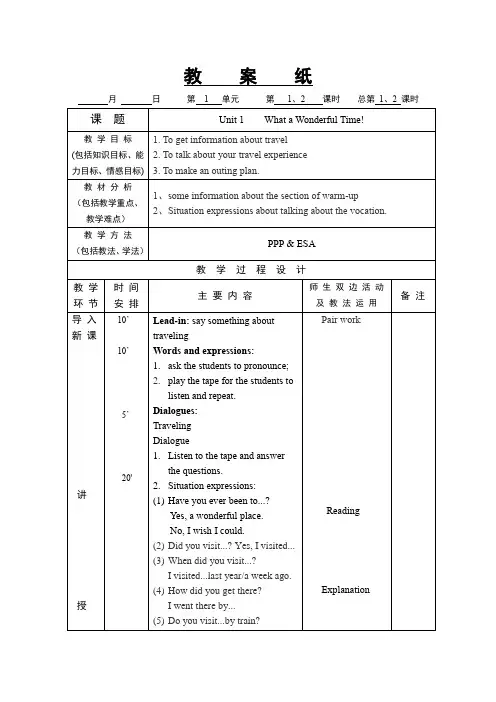
月日第 1 单元第1、2 课时总第1、2 课时(教学环节一般包括复习旧课、导入新课、讲授新课、学生操作、教师点评、归纳总结、布置作业等)月日第 1 单元第3、4 课时总第3、4 课时(教学环节一般包括复习旧课、导入新课、讲授新课、学生操作、教师点评、归纳总结、布置作业等月日第 1 单元第5、6 课时总第5、6 课时(教学环节一般包括复习旧课、导入新课、讲授新课、学生操作、教师点评、归纳总结、布置作业等)月日第 2 单元第1、2 课时总第7、8 课时(教学环节一般包括复习旧课、导入新课、讲授新课、学生操作、教师点评、归纳总结、布置作业等)月日第 2 单元第3、4 课时总第9、10 课时(教学环节一般包括复习旧课、导入新课、讲授新课、学生操作、教师点评、归纳总结、布置作业等月日第 2 单元第5、6 课时总第11、12 课时(教学环节一般包括复习旧课、导入新课、讲授新课、学生操作、教师点评、归纳总结、布置作业等)月日第 3 单元第1、2 课时总第13、14 课时(教学环节一般包括复习旧课、导入新课、讲授新课、学生操作、教师点评、归纳总结、布置作业等)月日第 3 单元第3、4 课时总第15、16 课时(教学环节一般包括复习旧课、导入新课、讲授新课、学生操作、教师点评、归纳总结、布置作业等月日第 3 单元第5、6 课时总第17、18 课时(教学环节一般包括复习旧课、导入新课、讲授新课、学生操作、教师点评、归纳总结、布置作业等)月日第 4 单元第1、2 课时总第19、20 课时(教学环节一般包括复习旧课、导入新课、讲授新课、学生操作、教师点评、归纳总结、布置作业等)教案纸月日第 4 单元第3、4 课时总第21、22 课时(教学环节一般包括复习旧课、导入新课、讲授新课、学生操作、教师点评、归纳总结、布置作业等教案纸月日第 4 单元第5、6 课时总第23、24 课时(教学环节一般包括复习旧课、导入新课、讲授新课、学生操作、教师点评、归纳总结、布置作业等)教案纸月日第 5 单元第1、2 课时总第25、26 课时(教学环节一般包括复习旧课、导入新课、讲授新课、学生操作、教师点评、归纳总结、布置作业等)教案纸月日第 5 单元第3、4 课时总第27、28 课时(教学环节一般包括复习旧课、导入新课、讲授新课、学生操作、教师点评、归纳总结、布置作业等教案纸月日第 5 单元第5、6 课时总第29、30 课时(教学环节一般包括复习旧课、导入新课、讲授新课、学生操作、教师点评、归纳总结、布置作业等)月日第 6 单元第1、2 课时总第31、32 课时(教学环节一般包括复习旧课、导入新课、讲授新课、学生操作、教师点评、归纳总结、布置作业等)月日第 6 单元第3、4 课时总第33、34 课时(教学环节一般包括复习旧课、导入新课、讲授新课、学生操作、教师点评、归纳总结、布置作业等月日第 6 单元第5、6 课时总第35、36 课时(教学环节一般包括复习旧课、导入新课、讲授新课、学生操作、教师点评、归纳总结、布置作业等)月日第7 单元第1、2 课时总第37、38 课时(教学环节一般包括复习旧课、导入新课、讲授新课、学生操作、教师点评、归纳总结、布置作业等)月日第7 单元第3、4 课时总第39、40 课时(教学环节一般包括复习旧课、导入新课、讲授新课、学生操作、教师点评、归纳总结、布置作业等月日第7 单元第5、6 课时总第41、42 课时(教学环节一般包括复习旧课、导入新课、讲授新课、学生操作、教师点评、归纳总结、布置作业等)月日第8 单元第1、2 课时总第43、44 课时(教学环节一般包括复习旧课、导入新课、讲授新课、学生操作、教师点评、归纳总结、布置作业等)月日第8 单元第3、4 课时总第45、46 课时(教学环节一般包括复习旧课、导入新课、讲授新课、学生操作、教师点评、归纳总结、布置作业等月日第8 单元第5、6 课时总第47、48 课时(教学环节一般包括复习旧课、导入新课、讲授新课、学生操作、教师点评、归纳总结、布置作业等)月日第9 单元第1、2 课时总第49、50 课时(教学环节一般包括复习旧课、导入新课、讲授新课、学生操作、教师点评、归纳总结、布置作业等)。
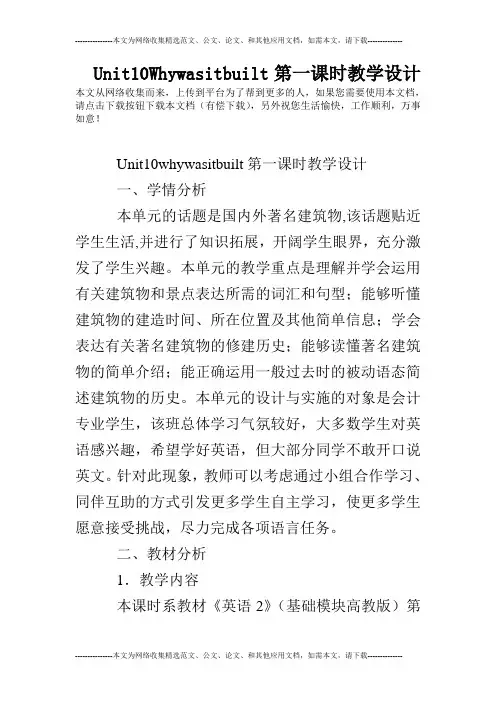
Unit10Whywasitbuilt第一课时教学设计本文从网络收集而来,上传到平台为了帮到更多的人,如果您需要使用本文档,请点击下载按钮下载本文档(有偿下载),另外祝您生活愉快,工作顺利,万事如意!Unit10whywasitbuilt第一课时教学设计一、学情分析本单元的话题是国内外著名建筑物,该话题贴近学生生活,并进行了知识拓展,开阔学生眼界,充分激发了学生兴趣。
本单元的教学重点是理解并学会运用有关建筑物和景点表达所需的词汇和句型;能够听懂建筑物的建造时间、所在位置及其他简单信息;学会表达有关著名建筑物的修建历史;能够读懂著名建筑物的简单介绍;能正确运用一般过去时的被动语态简述建筑物的历史。
本单元的设计与实施的对象是会计专业学生,该班总体学习气氛较好,大多数学生对英语感兴趣,希望学好英语,但大部分同学不敢开口说英文。
针对此现象,教师可以考虑通过小组合作学习、同伴互助的方式引发更多学生自主学习,使更多学生愿意接受挑战,尽力完成各项语言任务。
二、教材分析1.教学内容本课时系教材《英语2》(基础模块高教版)第十单元的第一课时,包括Lead-in&Listeningandspeaking 两部分,具体内容为:了解有关著名的建筑物,听懂关于著名建筑物的建造时间、所在位置及其他简单信息。
掌握有关表达建筑物的建造时间、所在位置等简单信息的词汇、句型。
2.教学重点、难点⑴教学重点听懂关于著名建筑物的简单信息,并掌握有关表达建筑物的建造时间、所在位置等简单信息的词汇、句型。
⑵教学难点获得在相对真实的情境下用合适的方式和语句询问和回答有关建筑物信息的能力。
三、教学目标1.知识目标(1)了解世界著名建筑物的专有名词,如:thePalacemuseum,theGoldenGateBridge,Stonehenge,Syd neyoperaHouse,thePisaTower,theTajmahaletc.(2)掌握与著名建筑物有关的词汇和短语,如guide,tourist,design,locate,revolution,pyramid,stair,exper t,keepout,collection,congress,include,morethan,rebuild,describe,description,electricity, etc(3)掌握表达建筑物的建造时间、所在位置等简单信息的词汇、句型。
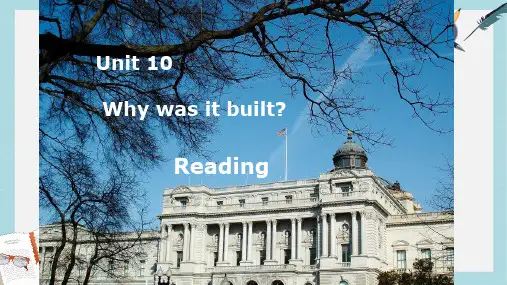
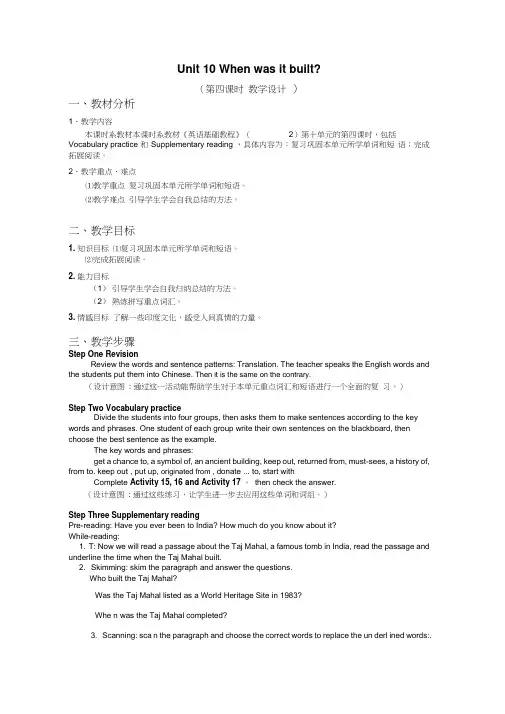
Unit 10 When was it built?(第四课时教学设计)一、教材分析1.教学内容本课时系教材本课时系教材《英语基础教程》(2)第十单元的第四课时,包括Vocabulary practice 和Supplementary reading ,具体内容为:复习巩固本单元所学单词和短语;完成拓展阅读。
2.教学重点、难点⑴教学重点复习巩固本单元所学单词和短语。
⑵教学难点引导学生学会自我总结的方法。
二、教学目标1. 知识目标⑴复习巩固本单元所学单词和短语。
⑵完成拓展阅读。
2. 能力目标(1)引导学生学会自我归纳总结的方法。
(2)熟练拼写重点词汇。
3. 情感目标了解一些印度文化,感受人间真情的力量。
三、教学步骤Step One RevisionReview the words and sentence patterns: Translation. The teacher speaks the English words and the students put them into Chinese. Then it is the same on the contrary.(设计意图: 通过这一活动能帮助学生对于本单元重点词汇和短语进行一个全面的复习。
)Step Two Vocabulary practiceDivide the students into four groups, then asks them to make sentences according to the key words and phrases. One student of each group write their own sentences on the blackboard, then choose the best sentence as the example.The key words and phrases:get a chance to, a symbol of, an ancient building, keep out, returned from, must-sees, a history of, from to. keep out , put up, originated from , donate ... to, start withComplete Activity 15, 16 and Activity 17 ,then check the answer.(设计意图: 通过这些练习,让学生进一步去应用这些单词和词组。
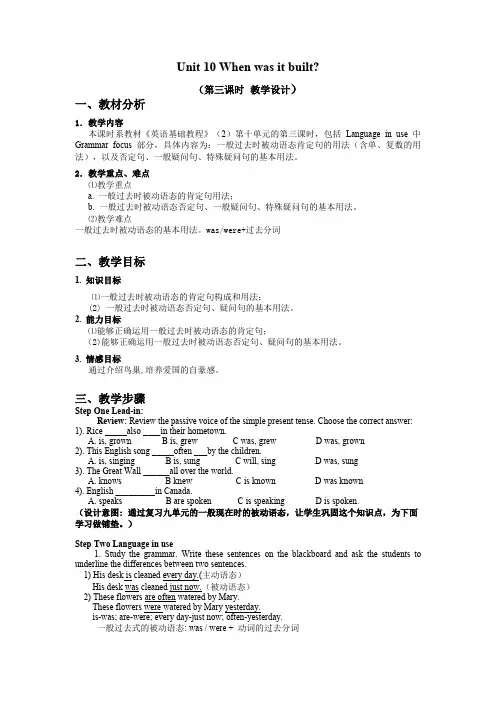
Unit 10 When was it built?(第三课时教学设计)一、教材分析1.教学内容本课时系教材《英语基础教程》(2)第十单元的第三课时,包括Language in use中Grammar focus部分,具体内容为:一般过去时被动语态肯定句的用法(含单、复数的用法),以及否定句、一般疑问句、特殊疑问句的基本用法。
2.教学重点、难点⑴教学重点a. 一般过去时被动语态的肯定句用法;b. 一般过去时被动语态否定句、一般疑问句、特殊疑问句的基本用法。
⑵教学难点一般过去时被动语态的基本用法。
was/were+过去分词二、教学目标1. 知识目标⑴一般过去时被动语态的肯定句构成和用法;(2)一般过去时被动语态否定句、疑问句的基本用法。
2. 能力目标⑴能够正确运用一般过去时被动语态的肯定句;(2)能够正确运用一般过去时被动语态否定句、疑问句的基本用法。
3. 情感目标通过介绍鸟巢,培养爱国的自豪感。
三、教学步骤Step One Lead-in:Review: Review the passive voice of the simple present tense. Choose the correct answer:1). Rice _____also ____in their hometown.A. is, grown B is, grew C was, grew D was, grown2). This English song _____often ___by the children.A. is, singing B is, sung C will, sing D was, sung3). The Great Wall ______all over the world.A. knows B knew C is known D was known4). English _________in Canada.A. speaks B are spoken C is speaking D is spoken.(设计意图: 通过复习九单元的一般现在时的被动语态,让学生巩固这个知识点,为下面学习做铺垫。
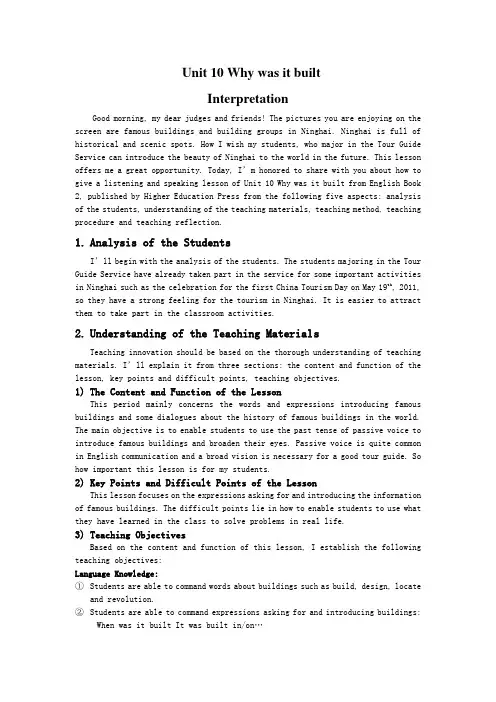
Unit 10 Why was it builtInterpretationGood morning, my dear judges and friends! The pictures you are enjoying on the screen are famous buildings and building groups in Ninghai. Ninghai is full of historical and scenic spots. How I wish my students, who major in the Tour Guide Service can introduce the beauty of Ninghai to the world in the future. This lesson offers me a great opportunity. Today, I’m honored to share with you about how to give a listening and speaking lesson of Unit 10 Why was it built from English Book 2, published by Higher Education Press from the following five aspects: analysis of the students, understanding of the teaching materials, teaching method, teaching procedure and teaching reflection.1.Analysis of the StudentsI’ll begin with the analysis of the students. The students majoring in the Tour Guide Service have already taken part in the service for some important activities in Ninghai such as the celebration for the first China Tourism Day on May 19th, 2011, so they have a strong feeling for the tourism in Ninghai. It is easier to attract them to take part in the classroom activities.2.Understanding of the Teaching MaterialsTeaching innovation should be based on the thorough understanding of teaching materials. I’ll explain it from three sections: the content and function of the lesson, key points and difficult points, teaching objectives.1)The Content and Function of the LessonThis period mainly concerns the words and expressions introducing famous buildings and some dialogues about the history of famous buildings in the world. The main objective is to enable students to use the past tense of passive voice to introduce famous buildings and broaden their eyes. Passive voice is quite common in English communication and a broad vision is necessary for a good tour guide. So how important this lesson is for my students.2) Key Points and Difficult Points of the LessonThis lesson focuses on the expressions asking for and introducing the information of famous buildings. The difficult points lie in how to enable students to use what they have learned in the class to solve problems in real life.3) Teaching ObjectivesBased on the content and function of this lesson, I establish the following teaching objectives:Language Knowledge:①Students are able to command words about buildings such as build, design, locateand revolution.②Students are able to command expressions asking for and introducing buildings:When was it built It was built in/on…Why was it built It was built to …Who designed it It was designed by…What was it used for It was used for…Language Skills:①Students are able to predict before listening and listen for detailed informationby catching the key words to understand the dialogues talking about the famous buildings②Students are able to talk about the famous buildings with each other by usingthe key words and expressionsCultural Awareness: Students are able to get familiar with the history of some famous western buildings.Affection:①Students are able to broaden their eyes by getting familiar with some famousbuildings in the world and love their own hometown by introducing its famous buildings.②Students are able to cooperate with others by selectively putting the materialstogether to make an introduction of one famous building.3.Teaching MethodsTo achieve the above teaching objectives, situational teaching method and task-based language teaching method are adopted in this class.4.Teaching ProceduresT eaching procedures are the most important of a successful teaching. Before class, apart from making a multi-media courseware and Question-Answer cards which will be used in the speaking activity, I’ll divide the students into groups of 6 according to their language ability. As for the students, they need to collect materials about famous buildings in Ninghai (such as pictures, videos, the location and so on). With everything prepared, here come the six teaching steps:Step 1: Lead-inI will play the video showing famous buildings in Ninghai one minute before class to help students begin their English learning in a relaxing atmosphere.With the help of the video, I smoothly begin the class by talking about the tourism in Ninghai to activate students’background knowledge and preset a task for the students: it is your honorable duty to introduce the famous buildings in Ninghai to the world. And all the following activities are to help them prepare for this duty.First of all, broaden their eyes. A matching competition will be held between groups and details about the buildings will be introduced later by showing more pictures and asking them the following questions: Where is it Why was it built to lead in the study of key expressions. Group cooperation can relieve students’fear caused by the unfamiliarity with the English expressions of these famous buildings while group competition can fully motivate their learning enthusiasm.Step 2: ListeningThe students may know a lot about one famous building, but how to introduce itto tourists I will introduce the magical blanket of Aladdin to link different teaching steps and change the whole boring listening process into a wonderful traveling to enjoy famous buildings in the world and experience how to guide a tourist to visit famous buildings at the same time. This is the point where I integrate the teaching materials and set an interesting situation for students.Students are certainly eager to begin their traveling, but which buildings are we going to visit They will listen to three tour guides introducing the three buildings and order the pictures. This step serves as preparation for the following activities by briefly introducing the background knowledge of three buildings, which follows the study law-from the easy to the difficult.Then we will arrive in the first stop of our wonderful travel-the Statue of Liberty. I’ll ask the students: If you are the tour guide, what questions do you think the tourists will ask Do you know the answers With their own predictions in mind, a flash will be followed to check the answers by circling the questions they hear and completing the fact file. In the above process, students are not passively asked to do some meaningless listening activities. Instead, they actively explore for the information through different listening strategies directed by different questions and experience the use of key expressions. The information technology makes it possible to let students play an initiative role in a vivid learning environment.Step 3: SpeakingThe Statue of Liberty is a gift from the French people, so in the following step, I’ll lead students to France to visit the Eiffel Tower. Students need to win the passports for themselves by helping the magical blanket finish the Question-Answer cards. They will read aloud after the tape, underline the questions about the information of buildings to put into the Question card of a tourist and then find the answers to put into the Information card of a tour guide. The listening activities act as a role of implicit learning, and then this activity is to cultivate students’ability to summarize and help students command the key expressions in an explicit way.After receiving enough input, now it’s time for the students to output. I will lead them to visit the Eiffel Tower by showing a flash to let students understand how to use Question-Answer cards to act out a dialogue. After that, we will be in the last stop of our wonderful travel. It’s students’ turn to guide me to visit the Great Wall. A video showing its beautiful scenery will be played and students need to act out a dialogue by using the provided Question-Answer Cards. By role playing, students become the masters of the class while the teacher is a helper who offers the information cards. They are given the opportunity to speak out and practice the key expressions again.Step 4: TaskEnsuring that the students have enough language foundation after a series of listening and speaking activities, the preset task at the beginning of the class is presented to them. They need to work in groups and finish the following tasks:First, share the materials they have collected with their group members and choose a famous building they all like.Then discuss with each other about the building and put together the materials to make an introduction of it.(Possible questions to think about: What was the building used for When was it built Who designed Why was it built Why is it famous Is there any interesting stories about it...)At last, each group should choose a representative to show the result to the whole class and then the whole class chooses the best tour guide according to the following standards:The standards not only act as guidance for the students to work out the group task during the discussion, but also attract the attention of the whole class during the show time.The highlight of this step is creating a language situation closely related with their major by making full use of local characteristics. And this is what I do to break through the difficult points of this lesson.Step Five Self-checkThe following step is self-check. It presents the key contents of this lesson to deepen students’ impression and also helps the teacher to check whether the targeted teaching objectives are reached or not. What’s more, it offers two different levels for students to choose from, which can meet the different needs of students in different language levels.Step Six HomeworkAfter class, students need to work in groups again and choose a famous building in Activity1. Collect as much information about it as possible by searching the Internet. Make full use of what they have learned in the class to make an oral presentation in the next class.5.Teaching ReflectionAs teachers, we should always help students study more efficiently and get readyfor their future study or future jobs. In this class, all the teaching activities are carefully designed to meet students’real needs and help students develop their overall language ability by playing an initiative role in a situation close to the real life and future career. And the information technology shows its great advantage in breaking through the key and difficult points of this lesson. It provides sounds, pictures and visual images such as flashes and videos to make it possible to let students intuitively experience the language used in scenes which they are unfamiliar with such as visiting the Statue of Liberty and Eiffel Tower.youtAt last, I’d like to show the layout as follows:Self-check Sheet。
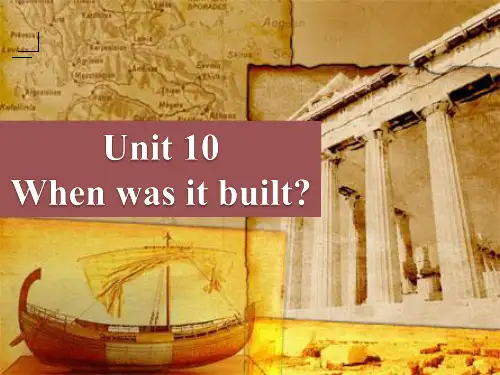

Unit 10 Why was it built?InterpretationGood morning, my dear judges and friends! The pictures you are enjoying on the screen are famous buildings and building groups in Ninghai. Ninghai is full of historical and scenic spots. How I wish my students, who major in the Tour Guide Service can introduce the beauty of Ninghai to the world in the future. This lesson offers me a great opportunity. Today, I’m honored to share with you about how to give a listening and speaking lesson of Unit 10 Why was it built? from English Book 2, published by Higher Education Press from the following five aspects: analysis of the students, understanding of the teaching materials, teaching method, teaching procedure and teaching reflection.1.Analysis of the StudentsI’ll begin with the analysis of the students. The students majoring in the Tour Guide Service have already taken part in the service for some important activities in Ninghai such as the celebration for the first China Tourism Day on May 19th, 2011, so they have a strong feeling for the tourism in Ninghai. It is easier to attract them to take part in the classroom activities.2.Understanding of the Teaching MaterialsTeaching innovation should be based on the thorough understanding of teaching materials. I’ll explain it from three sections: the content and function of the lesson, key points and difficult points, teaching objectives.1)The Content and Function of the LessonThis period mainly concerns the words and expressions introducing famous buildings and some dialogues about the history of famous buildings in the world. The main objective is to enable students to use the past tense of passive voice to introduce famous buildings and broaden their eyes. Passive voice is quite common in English communication and a broad vision is necessary fora good tour guide. So how important this lesson is for my students.2) Key Points and Difficult Points of the LessonThis lesson focuses on the expressions asking for and introducing the information of famous buildings. The difficult points lie in how to enable students to use what they have learned in the class to solve problems in real life.3) Teaching ObjectivesBased on the content and function of this lesson, I establish the following teaching objectives: Language Knowledge:①Students are able to command words about buildings such as build, design, locate andrevolution.②Students are able to command expressions asking for and introducing buildings:When was it built? It was built in/on…Why was it built? It was built to …Who design ed it? It was designed by…What was it used for? It was used for…Language Skills:①Students are able to predict before listening and listen for detailed information by catching thekey words to understand the dialogues talking about the famous buildings②Students are able to talk about the famous buildings with each other by using the key wordsand expressionsCultural Awareness: Students are able to get familiar with the history of some famous western buildings.Affection:①Students are able to broaden their eyes by getting familiar with some famous buildings in theworld and love their own hometown by introducing its famous buildings.②Students are able to cooperate with others by selectively putting the materials together tomake an introduction of one famous building.3.Teaching MethodsTo achieve the above teaching objectives, situational teaching method and task-based language teaching method are adopted in this class.4.Teaching ProceduresT eaching procedures are the most important of a successful teaching. Before class, apart from making a multi-media courseware and Question-Answer cards which will be used in the speaking activity, I’ll divide the students into groups of 6 according to their language ability. As for the students, they need to collect materials about famous buildings in Ninghai (such as pictures, videos, the location and so on). With everything prepared, here come the six teaching steps:Step 1: Lead-inI will play the video showing famous buildings in Ninghai one minute before class to help students begin their English learning in a relaxing atmosphere.With the help of the video, I smoothly begin the class by talking about the tourism in Ninghai to activate students’ background knowledge and preset a task for the students: it is your honorable duty to introduce the famous buildings in Ninghai to the world. And all the following activities are to help them prepare for this duty.First of all, broaden their eyes. A matching competition will be held between groups and details about the buildings will be introduced later by showing more pictures and asking them the following questions: Where is it? Why was it built? to lead in the study of key expressions. Group cooperation can relieve students’ fear caused by the unfamiliarity with the English expressions of these famous buildings while group competition can fully motivate their learning enthusiasm.Step 2: ListeningThe students may know a lot about one famous building, but how to introduce it to tourists? I will introduce the magical blanket of Aladdin to link different teaching steps and change the whole boring listening process into a wonderful traveling to enjoy famous buildings in the world and experience how to guide a tourist to visit famous buildings at the same time. This is the point where I integrate the teaching materials and set an interesting situation for students.Students are certainly eager to begin their traveling, but which buildings are we going to visit? They will listen to three tour guides introducing the three buildings and order the pictures. This step serves as preparation for the following activities by briefly introducing the background knowledge of three buildings, which follows the study law-from the easy to the difficult.Then we will arrive in the first stop of our wonderful travel-the Statue of Liberty. I’ll ask the students: If you are the tour guide, what questions do you think the tourists will ask? Do you know the answers? With their own predictions in mind, a flash will be followed to check the answers by circling the questions they hear and completing the fact file. In the above process, students are not passively asked to do some meaningless listening activities. Instead, they actively explore for the information through different listening strategies directed by different questions and experience the use of key expressions. The information technology makes it possible to let students play an initiative role in a vivid learning environment.Step 3: SpeakingThe Statue of Liberty is a gift from the French people, so in the following step, I’ll lead students to France to visit the Eiffel Tower. Students need to win the passports for themselves by helping the magical blanket finish the Question-Answer cards. They will read aloud after the tape, underline the questions about the information of buildings to put into the Question card of a tourist and then find the answers to put into the Information card of a tour guide. The listening activities act as a role of implicit learning, and then this activity is to cultivate students’ ability to summarize and help students command the key expressions in an explicit way.After receiving enough input, now it’s time for the students to output. I will lead them to visit the Eiffel Tower by showing a flash to let students understand how to use Question-Answer cards to act out a dialogue. After that, we will be in the last stop of our wonderful travel. It’s students’turn to guide me to visit the Great Wall. A video showing its beautiful scenery will be played and students need to act out a dialogue by using the provided Question-Answer Cards. By role playing, students become the masters of the class while the teacher is a helper who offers the information cards. They are given the opportunity to speak out and practice the key expressions again.Step 4: TaskEnsuring that the students have enough language foundation after a series of listening and speaking activities, the preset task at the beginning of the class is presented to them. They need to work in groups and finish the following tasks:First, share the materials they have collected with their group members and choose a famous building they all like.Then discuss with each other about the building and put together the materials to make an introduction of it.(Possible questions to think about: What was the building used for? When was it built? Who designed? Why was it built? Why is it famous? Is there any interesting stories about it...)At last, each group should choose a representative to show the result to the whole class and then the whole class chooses the best tour guide according to the following standards:The standards not only act as guidance for the students to work out the group task during the discussion, but also attract the attention of the whole class during the show time.The highlight of this step is creating a language situation closely related with their major by making full use of local characteristics. And this is what I do to break through the difficult points of this lesson.Step Five Self-checkThe following step is self-check. It presents the key contents of this lesson to deepen students ’ impression and also helps the teacher to check whether the targeted teaching objectives are reached or not. What’s more, it offers two different levels for students to choose from, which can meet the different needs of students in different language levels.Step Six HomeworkAfter class, students need to work in groups again and choose a famous building in Activity1. Collect as much information about it as possible by searching the Internet. Make full use of what they have learned in the class to make an oral presentation in the next class.5. Teaching ReflectionAs teachers, we should always help students study more efficiently and get ready for their future study or future jobs. In this class, all the teaching activities are carefully designed to meet students ’ real needs and help students develop their overall language ability by playing an initiative role in a situation close to the real life and future career. And the information technology shows its great advantage in breaking through the key and difficult points of this lesson. It provides sounds, pictures and visual images such as flashes and videos to make it possible to let students intuitively experience the language used in scenes which they are unfamiliar with such as visiting the Statue of Liberty and Eiffel Tower.6. LayoutAt last, I’d like to show the layout as follows:Self-check Sheet。
Unit10Whywasitbuilt?第三课时教学设计本文从网络收集而来,上传到平台为了帮到更多的人,如果您需要使用本文档,请点击下载按钮下载本文档(有偿下载),另外祝您生活愉快,工作顺利,万事如意!Unit10whywasitbuilt?第三课时教学设计一、教材分析1.教学内容本课时是教材《英语2》(基础模块高教版)第十单元的第三课时,内容包括writingandGrammarfocus 两部分。
具体内容为一般过去时的被动语态,与介绍著名的建筑物有关的词汇、短语以及巩固练习。
帮助学生完成对所熟悉的建筑物的简单描写,制作海报宣传介绍一个著名的建筑物2.教学重点、难点(1)教学重点1.有关建筑物介绍的词汇、句型的复习巩固和运用2.一般过去时的被动语态的正确运用(2)教学难点仿照上个课时的内容,练习用本单元学过的重点词句写出完整的句子,并组织成一个文段,运用所学知识点讲述一个建筑物的历史。
能够简单描写著名的建筑物,并制作成海报。
二、教学目标1.知识目标掌握与建筑物相关信息的主要词汇,如:design;open;complete;change;locate;rebuild掌握与建筑物相关的短语,如:beusedfor;bestarted;befamousfor;belocatedin;setup;m oveinto练习用本单元学过的重点词句写出完整的句子2.能力目标(1)学生能运用相关词汇,句型表达参与著名建筑物介绍的的相关内容。
(2)学生能讲述一个建筑物的历史。
教学步骤SteponeLead-in:theInternet,,通过上网进入thelibraryofcongress,点击主页上左边generalinformation中的“Aboutlibrary”,,letthemguess:what’sthenameofit?ItislocatedinthewestofBeijing.Ithasmorethan24millionitemsinitscollection.ItisthefifthlargestlibraryallovertheworldSteptwowriting1909openedandnamed/Beipinglibrary1916manybooks/receivedfromothers1949renamed/BeijingLibrary1987NationalLibraryofchina/asitsnewnameIn1909,thelibrarywasopenedandnamedasBeijingLibrary.In1916,manybookswerereceivedfromothers.In1949,thelibrarywasrenamedasBeijingLibrary.In1950,itusedNationalLibraryofchinaasitsnewname.,Eg:Hello,…I’mfrom…’,whichhasmorethan24millionitemsinitscollect ion……Thankyouverymuch.StepThreeLanguageinusewhenwasitbuilt?whodesignedit?whywasitbuilt? ThenletSsanswersomequestionsaboutthelibraryofcongressincompletesentences.whenwasitopened?whatwerekeptinoneroomofthecapitolbuilding?whenwereallofthebooksburntbyBritishSoldiers?Be—was/were+PPStepFourReading’,firststudentsreaditandcompleteit,,checktheanswer andexplainsomedifficultpoints.StepsixHomeworkwriteacomposition:thehistoryofourschool板书设计Unit10whywasitbuiltwas/were+ppItwasdesignedIn1909ItwasopenedandnamedasBeijingLibrary.manybookswerereceivedfromothers.ThelibrarywasrenamedasBeijingLibrarywerekeptwereburntwascompletedwasdiscoveredwascooledwerewarmedmakescomes本文从网络收集而来,上传到平台为了帮到更多的人,如果您需要使用本文档,请点击下载按钮下载本文档(有偿下载),另外祝您生活愉快,工作顺利,万事如意!。
Unit 10 When was it built?(第二课时教学设计)一、教材分析1.教学内容本课时系教材《英语基础教程》(2)第十单元的第二课时,包括Reading and writing 部分,具体内容为:了解认识介绍大英博物馆的英文表达;读懂介绍大英博物馆的短文;能根据关键句型写出关于大英博物馆的简要介绍;感受世界最大博物馆的辉煌。
2.教学重点、难点1. 知识目标⑴教学重点学会用be open to, be used as, be put up, originated from, donate ... to, start with, was established… be keen on, be moved to, people of all ages, because of.等单词和短语介绍建筑特点的句型;⑵教学难点灵活正确使用介绍建筑特点的的句型;二、教学目标1. 知识目标⑴ 掌握大英博物馆相关的词汇,如:be open to, be used as, be put up, originated from, donate ... to, start with, was established… be keen on, be moved to, people of all ages, because of, increase, landmark,lecturer,mysterious,originate,preserve,prison,public,attract, annually, appoint, release, remarkable.⑵掌握介绍大英博物馆使用的句型,如:It was established…The natural history col lections were moved to…When was it built?It is one of the…It originated from…2. 能力目标(1) 灵活正确使用介绍大英博物馆的句型;(2)能根据关键句型写出大英博物馆的简要情况。
Unit 10 When was it built?(第一课时教学设计)一、单元内容分析本单元的话题是介绍著名建筑。
教学重点是正确应用与建筑相关的词汇和句型介绍著名建筑。
具体为:能够听懂与建筑相关话题的对话;正确及熟练运用英语谈论相关建筑;能读懂关于建筑的文章;简单描绘建筑的一些基本情况;同时了解一些中外著名建筑物的特色及相关的历史文化知识。
本单元的语法点为过去式的被动语态。
本单元是以著名建筑为依托,在九单元一般现在时的被动语态的基础上进一步学习过去式的被动语态。
因此,教师应充分结合上一个单元学习的知识点,通过合理的设计,在帮助学生复习的同时,逐渐地融入新内容,有效的完成词汇听、说、读、写四个任务。
在谈论建筑及阅读相关文章的过程中,陶冶学生的心灵,感受人类伟大的智慧。
本单元设计成四个课时:第一课时 Lead in + Listening and speaking第二课时 Reading and writing第三课时Grammar focus (Passive Voice of the past tense)第四课时 Vocabulary practice + Supplementary reading二、分课时教学设计第一课时 Lead in + Listening and Speaking一、教材分析1.教学内容本课时系教材《英语基础教程》(2)第十单元的第一课时,包括Lead-in & Listening and speaking两部分,具体内容为:熟悉关于建筑的词汇,听懂并能谈论有关建筑的对话。
2.教学重点、难点⑴教学重点能够听说课文中出现的著名建筑的词汇;能够听懂和谈论介绍建筑的词汇、短语和简单对话。
⑵教学难点在模拟或真实语境中谈论著名建筑。
二、教学目标1.知识目标⑴掌握与建筑相关的词汇,如:The Statue of Liberty,The Eiffel Tower,The Tower of London,The Great Pyramid,Big Ben,The Great Wall,get a chance to, a symbol of,an ancient building,keep out,returned from,must-sees,a history of,from…to….⑵掌握介绍建筑所使用的句型,如:---Could you please tell me something about …?---When was it built?---Why was it built?---It was first built/used as…2.能力目标⑴学生能听懂谈论建筑方面的对话;⑵学生能应用基本句型进行以介绍建筑为主题的简单交谈;(3)对以上介绍建筑常用的基本词汇和句型达到听、说应用的程度。
Unit10 Why was it built?(第一课时教学设计)【课题】Unit10 Why was it built?【课时】第1课时(45分钟)【设计理念】本教案以学生为主体,以任务型教学为中心而设计,通过多媒体网络课件的图像、声音、动画、文字等多种信息功能激发学生的学习兴趣和内在学习动力,设置层层递进的学习任务,在做中学,在做中练,在做中巩固,使学生掌握基本的语句表达,设置真实情境,让学生能以导游的身份简单介绍著名建筑。
在运用英语完成任务的过程中不仅学习英语语言知识,更培养了学生用英语获取信息、处理信息及分析与解决的能力。
【学情简析】本单元的话题是国内外著名建筑物, 有助于开阔学生眼界,激发学生兴趣。
是本课时的教学重点是要求学生能够听懂建筑物的建造时间、所在位置及其他简单信息;能够读懂著名建筑物的简单对话;理解并学会运用有关建筑物和景点表达所需的词汇和句型;能正确运用一般过去时的被动语态简单介绍建筑物的历史。
本单元的设计对象是国贸专业学生,该班总体学习气氛较好,大多数学生对英语感兴趣,希望学好英语,但口语表达能力不强,大部分同学不敢开口说英文。
针对此现象,考虑通过教师铺垫、同伴互助、小组合作学习的方式引导更多学生自主学习,使更多学生愿意参与教学活动,尽力完成各项语言任务。
【教材解析】1.教学内容本课时系教材《英语2》(基础模块高教版)第十单元的第一课时,包括Lead-in & Listening and speaking两部分,具体内容为:了解有关著名的建筑物,听懂关于著名建筑物的建造时间、所在位置及其他简单信息。
掌握有关表达建筑物的建造时间、所在位置等简单信息的词汇、句型。
2. 教学目标(1)语言知识目标了解世界著名建筑物的专有名词,如the Golden Gate Bridge,the Palace Museum,Stonehenge,Sydney Opera House,the Pisa Tower,the Taj Mahal,Statue of Liberty, Eiffel Tower etc。
高教版中职英语基础模块第2册Unit10Whywasitbuiltword说课稿-精品2020-12-12【关键字】英语、基础InterpretationGood morning, my dear judges and friends! The pictures you are enjoying on the screen are famous buildings and building groups in Ninghai. Ninghai is full of historical and scenic spots. How I wish my students, who major in the Tour Guide Service can introduce the beauty of Ninghai to the world in the future. This lesson offers me a great opportunity. Today, I’m honored to share with you about how to give a listening and speaking lesson of Unit 10 Why was it built? from English Book 2, published by Higher Education Press from the following five aspects: analysis of the students, understanding of the teaching materials, teaching method, teaching procedure and teaching reflection.1.Analysis of the StudentsI’ll begin with the analysis of the students. The students majoring in the Tour Guide Service have already taken part in the service for some important activities in Ninghai such as the celebration for the first China Tourism Day on May 19th, 2011, so they have a strong feeling for the tourism in Ninghai. It is easier to attract them to take part in the classroom activities.2.Understanding of the Teaching MaterialsTeaching innovation should be based on the thorough understanding of teaching materials. I’ll explain it from three sections: the content and function of the lesson, key points and difficult points, teaching objectives.1)The Content and Function of the LessonThis period mainly concerns the words and expressions introducing famous buildings and some dialogues about the history of famous buildings in the world. The main objective is to enable students to use the past tense of passive voice to introduce famous buildings and broaden their eyes. Passive voice is quite common in English communication and a broad vision is necessary fora good tour guide. So how important this lesson is for my students.2) Key Points and Difficult Points of the LessonThis lesson focuses on the expressions asking for and introducing the information of famous buildings. The difficult points lie in how to enable students to use what they have learned in the class to solve problems in real life.3) Teaching ObjectivesBased on the content and function of this lesson, I establish the following teaching objectives: Language Knowledge:①Students are able to command words about buildings such as build, design, locate andrevolution.②Students are able to command expressions asking for and introducing buildings:When was it built? It was built in/on…Why was it built? It was built to …Who design ed it? It was designed by…What was it used for? It was used for…Language Skills:①Students are able to predict before listening and listen for detailed information by catching thekey words to understand the dialogues talking about the famous buildings②Students are able to talk about the famous buildings with each other by using the key wordsand expressionsCultural Awareness: Students are able to get familiar with the history of some famous western buildings.Affection:①Students are able to broaden their eyes by getting familiar with some famous buildings in theworld and love their own hometown by introducing its famous buildings.②Students are able to cooperate with others by selectively putting the materials together tomake an introduction of one famous building.3.Teaching MethodsTo achieve the above teaching objectives, situational teaching method and task-based language teaching method are adopted in this class.4.Teaching ProceduresT eaching procedures are the most important of a successful teaching. Before class, apart from making a multi-media courseware and Question-Answer cards which will be used in the speaking activity, I’ll divide the students into groups of 6 according to their language ability. As for the students, they need to collect materials about famous buildings in Ninghai (such as pictures, videos, the location and so on). With everything prepared, here come the six teaching steps:Step 1: Lead-inI will play the video showing famous buildings in Ninghai one minute before class to help students begin their English learning in a relaxing atmosphere.With the help of the video, I smoothly begin the class by talking about the tourism in Ninghai to activate students’ background knowledge and preset a task for the students: it is your honorable duty to introduce the famous buildings in Ninghai to the world. And all the following activities are to help them prepare for this duty.First of all, broaden their eyes. A matching competition will be held between groups and details about the buildings will be introduced later by showing more pictures and asking them the following questions: Where is it? Why was it built? to lead in the study of key expressions. Group cooperation can relieve students’ fear caused by the unfamiliarity with the English expressions of these famous buildings while group competition can fully motivate their learning enthusiasm. Step 2: ListeningThe students may know a lot about one famous building, but how to introduce it to tourists? I will introduce the magical blanket of Aladdin to link different teaching steps and change the whole boring listening process into a wonderful traveling to enjoy famous buildings in the world and experience how to guide a tourist to visit famous buildings at the same time. This is the pointwhere I integrate the teaching materials and set an interesting situation for students.Students are certainly eager to begin their traveling, but which buildings are we going to visit? They will listen to three tour guides introducing the three buildings and order the pictures. This step serves as preparation for the following activities by briefly introducing the background knowledge of three buildings, which follows the study law-from the easy to the difficult.Then we will arrive in the first stop of our wonderful travel-the Statue of Liberty. I’ll ask the students: If you are the tour guide, what questions do you think the tourists will ask? Do you know the answers? With their own predictions in mind, a flash will be followed to check the answers by circling the questions they hear and completing the fact file. In the above process, students are not passively asked to do some meaningless listening activities. Instead, they actively explore for the information through different listening strategies directed by different questions and experience the use of key expressions. The information technology makes it possible to let students play an initiative role in a vivid learning environment.Step 3: SpeakingThe Statue of Liberty is a gift from the French people, so in the following step, I’ll lead students to France to visit the Eiffel Tower. Students need to win the passports for themselves by helping the magical blanket finish the Question-Answer cards. They will read aloud after the tape, underline the questions about the information of buildings to put into the Question card of a tourist and then find the answers to put into the Information card of a tour guide. The listening activities act as a role of implicit learning, and then this activity is to cultivate students’ ability to summarize and help students command the key expressions in an explicit way.After receiving enough input, now it’s time for the students to output. I will lead them to visit the Eiffel Tower by showing a flash to let students understand how to use Question-Answer cards to act out a dialogue. After that, we will be in the last stop of our wonderful travel. It’s students’turn to guide me to visit the Great Wall. A video showing its beautiful scenery will be played and students need to act out a dialogue by using the provided Question-Answer Cards. By role playing, students become the masters of the class while the teacher is a helper who offers the information cards. They are given the opportunity to speak out and practice the key expressions again.Step 4: TaskEnsuring that the students have enough language foundation after a series of listening and speaking activities, the preset task at the beginning of the class is presented to them. They need to work in groups and finish the following tasks:First, share the materials they have collected with their group members and choose a famous building they all like.Then discuss with each other about the building and put together the materials to make an introduction of it.(Possible questions to think about: What was the building used for? When was it built? Who designed? Why was it built? Why is it famous? Is there any interesting stories about it...)At last, each group should choose a representative to show the result to the whole class and then the whole class chooses the best tour guide according to the following standards:The standards not only act as guidance for the students to work out the group task during the discussion, but also attract the attention of the whole class during the show time.The highlight of this step is creating a language situation closely related with their major by making full use of local characteristics. And this is what I do to break through the difficult points of this lesson.Step Five Self-checkThe following step is self-check. It presents the key contents of this lesson to deepen students’ impression and also helps the teacher to check whether the targeted teaching objectives are reached or not. What’s more, it offers two different levels for students to choose from, which can meet the different needs of students in different language levels.Step Six HomeworkAfter class, students need to work in groups again and choose a famous building in Activity1. Collect as much information about it as possible by searching the Internet. Make full use of what they have learned in the class to make an oral presentation in the next class.5.Teaching ReflectionAs teachers, we should always help students study more efficiently and get ready for their future study or future jobs. In this class, all the teaching activities are carefully designed to meet students’real needs and help students develop their overall language ability by playing an initiative role in a situation close to the real life and future career. And the information technology shows its great advantage in breaking through the key and difficult points of this lesson. It provides sounds, pictures and visual images such as flashes and videos to make it possible to let students intuitively experience the language used in scenes which they are unfamiliar with such as visiting the Statue of Liberty and Eiffel Tower.youtAt last, I’d like to show the layout as follows:Self-check Sheet。